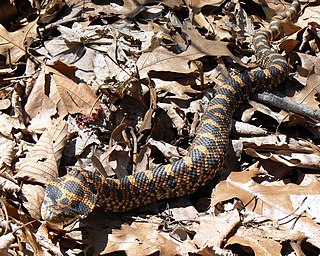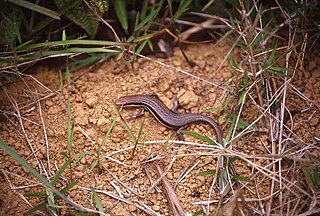
The Boidae, commonly known as boas or boids, are a family of nonvenomous snakes primarily found in the Americas, as well as Africa, Europe, Asia, and some Pacific islands. Boas include some of the world's largest snakes, with the green anaconda of South America being the heaviest and second-longest snake known; in general, adults are medium to large in size, with females usually larger than the males. Six subfamilies comprising 15 genera and 54 species are currently recognized.

Uroplatus is a genus of geckos, commonly referred to as leaf-tail geckos or flat-tailed geckos, which are endemic to Madagascar and its coastal islands, such as Nosy Be. They are nocturnal, insectivorous lizards found exclusively in primary and secondary forest.

Boa is a genus of boas found in Mexico, the Caribbean, and Central and South America. Five extant species, and one extinct, are currently recognized.

Hognose snake is a common name for several unrelated species of snakes with upturned snouts, classified in two colubrid snake families and one pseudoxyrhophiid snake family.

Leioheterodon is a genus of harmless pseudoxyrhophiid snakes found only on the island of Madagascar. Three species are currently recognized. Common names include Malagasy hognose snakes, Malagasy brown snakes and Malagasy menarana snakes.

Acrantophis dumerili, commonly known as Dumeril's boa, is a species of non-venomous snake in the family Boidae. The species is endemic to Madagascar. No subspecies are currently recognized.

Acrantophis is a genus of terrestrial boid snakes endemic to the island of Madagascar.

Acrantophis madagascariensis is a species of boid snake in the subfamily Sanziniinae that is endemic to the island of Madagascar. Its common names include the Madagascar ground boa and Malagasy ground boa.

The Boinae are a purported subfamily of boas found in Central and South America, as well as the West Indies. In the Integrated Taxonomic Information System (ITIS), Boinae is considered an invalid synonym of Boidae.
Xenotyphlops grandidieri is a species of blind snake in the family Xenotyphlopidae. The species is endemic to Madagascar. There are no subspecies that are recognized as being valid.

Corallus cropanii, or Cropani's tree boa, is a species of boa, a snake in the family Boidae. The species is endemic to the state of São Paulo, Brazil. Like all boas, it is not venomous. No subspecies are currently recognized. Until 2017, no specimen of this snake had been seen alive since 1953 and only five dead specimens had been collected since then, but in late January 2017, an adult female Cropan's tree boa measuring 1.7 m was captured by locals in Ribeira who brought it to herpetologists from the Instituto Butantan and the Museum of Zoology of the University of São Paulo, who radio-tagged and released the animal to learn more about the species' behavior.

Leioheterodon madagascariensis, the Malagasy Giant Hognose or Madagascar Giant Hognose, is a harmless species of snake that can be found in Madagascar, Nosy Be, Nosy Sakatia and Comoros Islands. They can grow from 130 to 180 cm. It is thought by some to have been introduced to the Grande Comoro.

Ithycyphus miniatus is a species of mildly venomous snake in the family Pseudoxyrhophiidae. The species is native to Madagascar.

Calumma nasutum, the Madagascar pimple-nose chameleon, is a small species of chameleon found in Madagascar. The taxonomic identity of the species is currently uncertain and in need of revision, and this revision is likely to result in several newly described species. Several different data sets indicate that C. nasutum is a complex of several species.

The Sanziniinae are a subfamily of boid snakes containing four species endemic to the island of Madagascar. Common names include Madagascar boas and Malagasy boas.
Phisalixella is a genus of pseudoxyrhophiid snakes endemic to the island of Madagascar. They are harmless to humans.

The Nosy Komba ground boa is a boa species endemic to the island of Madagascar. It is brownish in colour and is found on the western side of the island. It was once considered conspecific with the Madagascar tree boa. Like all other boas, it is not venomous.

Thamnosophis stumpffi, commonly known as the yellow-striped water snake, is a species of snake in the subfamily Pseudoxyrhophiinae of the family Pseudoxyrhophiidae. The species is endemic to Madagascar.

Trachylepis gravenhorstii, also known commonly as Gravenhorst's mabuya, is a species of skink, a lizard in the family Scincidae. The species is endemic to Madagascar.


















